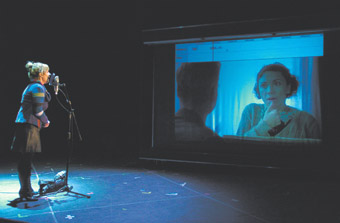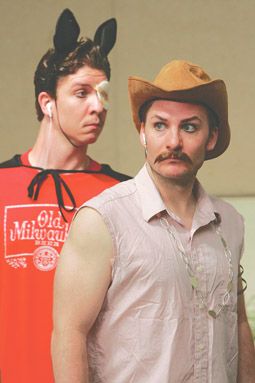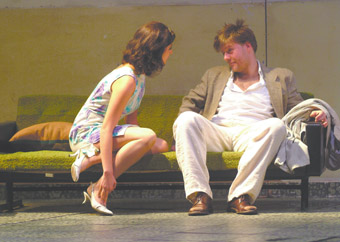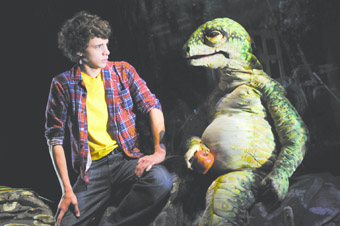the other dancing
keith gallasch: no dice, lipsynch, ivanov, the nargun and the stars

Frederike Bedard, Lipsynch, Ex Machina
photo Erick Labbé
Frederike Bedard, Lipsynch, Ex Machina
ALTHOUGH THE GLOBAL ECONOMY WAS IN STEEP DOWNTURN AND THE SYDNEY FESTIVAL WAS FEELING SOME OF THE CRUNCH, THERE WAS STILL MASS DANCING IN THE STREETS, LED BY GARRY STEWART, THE FONDUE SET AND OTHERS IN THE CITY ON THE OPENING NIGHT. WHEN WE ARRIVED AT THE HUMBLE ABRAHAM MOTT HALL IN THE ROCKS WE FOUND THE CO-DIRECTORS OF NEW YORK’S NATURE THEATRE OF OKLAHOMA MAKING US WHITE BREAD SANDWICHES—CHOICE OF PEANUT BUTTER AND JELLY OR HAM AND CHEESE WITH MAYONNAISE OR MUSTARD—AND THROWING IN A CAN OF DIET COKE OR A DR PEPPER. THESE WERE INCLUDED IN THE TICKET PRICE, BUT THERE WAS FOR A MOMENT A HINT OF THE BREADLINE, ACCENTUATED BY NATURE THEATRE’S LOW, LOW BUDGET FOUR-HOUR PRODUCTION, NO DICE, PERFORMED IN ALMOST OVERWHELMING, HUMID SUMMER HEAT. HERE WAS A SHOW THAT, UNLIKE CHRISTOPHER WHEELDON’S STRAITJACKETED MORPHOSES BALLETS, REALLY DANCED, IN WORD AND BODY.
Although No Dice yielded exhilarations and profundities that could not be approached by Lipsynch, the nine-hour Robert Lepage production also danced when it was not locked into an increasingly silly melodrama or hamstrung by superfluous effects. The complexly integrated set, operated by a huge team of visible stage hands and technicians, turned itself inside out and rotated in a waltz of overlapping lives and cultures, homes, hospitals and sound and film studios. Best of all was Lipsynch’s attention to sound and listening—the match, or not, between voice and body, the mismatch between seeing and hearing, the aural trickery of filmmaking, the loss of voice to a tumour and its recovery through song, and much, much more. In one scene we witness a female employee dealing with night-time customers in a bookshop. We see her though the window; we can’t hear what is said. We know she’s recently been released from psychiatric care. Outside the shop we see the two ghosts that haunt her, demanding her attention. She seems to ignore them, but we wonder if she is coping at all well with her customers. The set turns and we watch the whole scene again, hearing what is said. We wait anxiously for the ghosts to appear. They don’t. And what we hear contradicts all our expectations and projections. Here is a woman on the way to recovery, returning to engagement, listening and poetry. If only Lepage had applied this approach to his Dickensian plotting, where creaking predictability and deterministic Roman Catholicism make a saint of a Nicaraguan victim of the sex slave trade, but never a real person, always a cipher. Whereas the sonic world of Lipsynch floats and fascinates in tandem with the perspectives offered by the mutating set, Lepage nails his narrative to the stage floor.

Zachary Oberzan, Jarid Rychtarik, No Dice, Nature Theater of Oklahoma
photo Prudence Upton
Zachary Oberzan, Jarid Rychtarik, No Dice, Nature Theater of Oklahoma
In No Dice, there was dancing towards the end of each of the two acts. It was inexplicable, but bracing, wild yet choreographed and as idiosyncratic as the rest of this remarkable show—as if a release from the incredible labour of human conversation we’d been witnessing. The Nature Theatre of Oklahama performs recorded conversations. Roslyn Oades directs similar work for Urban Theatre Projects but in a different way, resulting in a lyrical, revealing naturalism (p36). Nature Theatre does quite the opposite. The No Dice performers hear edited telephone conversations on their in synch iPods and deliver them according to a set of rules, which include a fixed number of strange gestures (sourced from a magician, disco dancing and blocking clichés from the stage and soap opera) as well as a range of accents. The pacing of the speech is slow and hyper-emphatic, the volume is high, the rhythm heavily accented, allowing for an aural slow motion analysis of conversational patterns and personality traits. Utterly shorn of context, apparently banal conversations about work (whether in call centres or in the theatre), family and the best performance of Hamlet (Mel Gibson; the others “made Hamlet look like a sissy”) become very funny but also assume a surreal gravitas—they seem crazy but deeply meaningful as we grow adept at listening and decoding. Conversational tropes recur, whole passages are repeated with roles reversed and accents dropped. But at all times the bespectacled Hasidic pirate, the New York, moustachioed cowboy and the sparky, fishnet-stockinged showgirl (and their Batboy hip-hopper-cum-sound artist, a lean keyboardist and the two guest-spotting directors) perform everyday talk as if every word is of the utmost importance. And so it is. In a late reversal, the hyperreal formula is dropped, the stage darkened, and the projected transcript of one of the conversations we’ve heard scrolls down. We hear it as well, at normal conversational pace. The key speaker turns out to be female, not male after all, and is the mother of one of the performers talking to the show’s male director. She’s idiosyncratic, quick and droll. She talks about dancing in a wheelchair. We’re now hyper-attentive, curiously moved. And then the company dances (“…dance will solve all the world’s problems”) and we celebrate as one.
The Belarus Free Theatre (see David Williams’ interview/review on page 9) in Being Harold Pinter also made us listen, and read very fast as the surtitles rattled by. Fragments from Pinter plays, from early works to late, took us from threatening moments in everyday life to the overt threats, tortures and murders of totalitarian states. What we heard was Pinter’s text delivered at breakneck pace, largely bereft of classic pauses, but when they did occur it was at great length, opening up chasms of anxiety and pure fear. What we saw was reminiscent of western radical theatre of the 60s and 70s: stark symbolism built from deployment of simple props and neatly choreographed correlatives to the text, here performed with subtlety and passion.

Krno Fekete, Adel Jordan, Ivanov, Katona Jozsef Theatre
photo Kata Schiller
Krno Fekete, Adel Jordan, Ivanov, Katona Jozsef Theatre
Reading the surtitles in the Katona Josef Theatre’s Ivanov was more leisurely and the unintelligible Hungarian a musical delight. This early Chekhov proved to be the festival sleeper (No Dice, on the other hand, was sold out almost as soon as bookings opened), a totally engaging, faithful account of the work. It too danced. The opening solos and duets involving Ivanov, his chair and the comings and goings of visitors are preludes to other intimate patternings and larger scale social events involving the 22-strong ensemble. Director Tamas Ascher deploys his actors with the eye of a film director, constantly shifting our perspective within the frame. The 1960s setting is a run-down building, doubling as Ivanov’s bankrupt farm and the local club, in the declining Soviet Republic of Hungary. So it’s not surprising that the production is reminiscent of films of the period, not least those of the Czech director Milos Forman. Every character, however minor, is closely observed, a touch eccentric and living in a bitter world eased by wonderful comedy, sometimes verging on slapstick, but always rooted in the absurdities of appalling local prejudices, a failing social system and personal weaknesses. The transposition of the play from late Czarist Russia to 60s Hungary works perfectly, and there’s much in Ivanov about racism, the destruction of nature, the challenges of rural life and the enduring agonies of love and indecision that seem utterly contemporary. What impressed about Ivanov were the unforced historical transposition, superb ensemble playing and rivetting principal players. It was above all a production faithful to the play but with the provocative visual and choreographic sensibility of 21st century performance and, at the same time, a disarming intimacy.

Tom Green & the Potkoorok, The Nargun and the Stars, Erth
photo Heidrun Löhr
Tom Green & the Potkoorok, The Nargun and the Stars, Erth
Erth’s The Nargun and the Stars, an adaptation of the famous Australian novel for children, also danced. Simon discovers spirit creatures in the bush around his cousins’ farm where he has been sent after his parents’ death in a car crash. There he encounters the spirit life of the local environment realised here as magical creatures: the monkey-ish Turongs, the boy’s lizardy confidante, Potkoorok, the cute fruitbat-like Nyols and the massive, stage-filling Nargun, a rock monster attracted out of its territory by its first sight of the stars. The Nargun is troubling the local spirit ecology while developers ruin the natural one. The puppeteering of Bryony Anderson’s wonderful creations is a delight, especially for the Nyols, flying in precise formation, settling on Simon, shaping his movements into comic dance. I subsequently learned that a number of the puppeteers have dance backgrounds. It shows.
The setting is realised virtually in Sam James’ projections of farm house, forests, cave, night sky and rain, and physically in Steve Howarth’s design, which includes a rock pool, a huge grader and tall inflatable trees. The two layers of design, aided by Bernie Tan’s necessarily discreet lighting, merge beautifully, allowing actors, puppets and images to magically live as one, not least in an underwater swimming scene. James’ images are multi-layered, rich in detail, animated and provide exciting shifts in perspective and depth of field. The performances are good, the puppeteering and the multimedia design are exceptional and the lucid direction by Wesley Enoch and Erth’s Scott Wright of Verity Laughton’s adaptation yields laughter, anxiety and surprise. While Wrightson’s tale was progressive for the 1970s and still has many strengths, its fictional imagining of an Aboriginal spirit world now seems culturally awkward (this is compounded by the voice-over narration). But that’s the challenge that comes with realising any classic in performance and, to their credit, the collaborators largely override these concerns with a vividly memorable creation.
Ex Machina, Lipsynch, director Robert Lepage, text Lepage, performers & dramaturg Marie Gignac, set Jean Hazel, lighting Etienne Boucher, sound Jean-Sebastien Cote, Theatre Royal, Jan 11-18; Nature Theatre of Oklahoma, No Dice, conceived and directed by Pavol Liska, Kelly Copper, performers Anne Gridley, Robert M Johansen, Zachary Oberzan, Jarid Rychtarik, Kristin Worrall, design Peter Nigrini, Abraham Mott Hall, Jan 11-16; Belarus Free Theatre, Being Harold Pinter (see p9); Katona Josef Theatre, Ivanov, by Anton Chekhov, director Tamas Ascher, set Zsolt Khell, Drama Theatre, Sydney Opera House, Jan 22-27; Erth—Visual and Physical, The Nargun & the Stars, from the novel by Patricia Wrightson, adapted by Verity Laughton, co-directors Wesley Enoch, associate puppetry director Colin Sneesby, performers Annie Byron, Tom Green, Bill Young, puppeteers Jacob Boehme, Joshua Bond, Johanna Clancy, Sharon Kerr, Colin Sneesby, set Steve Howarth, puppet design Bryony Anderson, composer Phil Downing, audiovisual artist Sam James, lighting Bernie Tan, producer Performing Lines, Parramatta Riverside Theatres, Jan 15-21, Perth International Arts Festival, Feb 18-March 1
RealTime issue #89 Feb-March 2009 pg. 6,8






